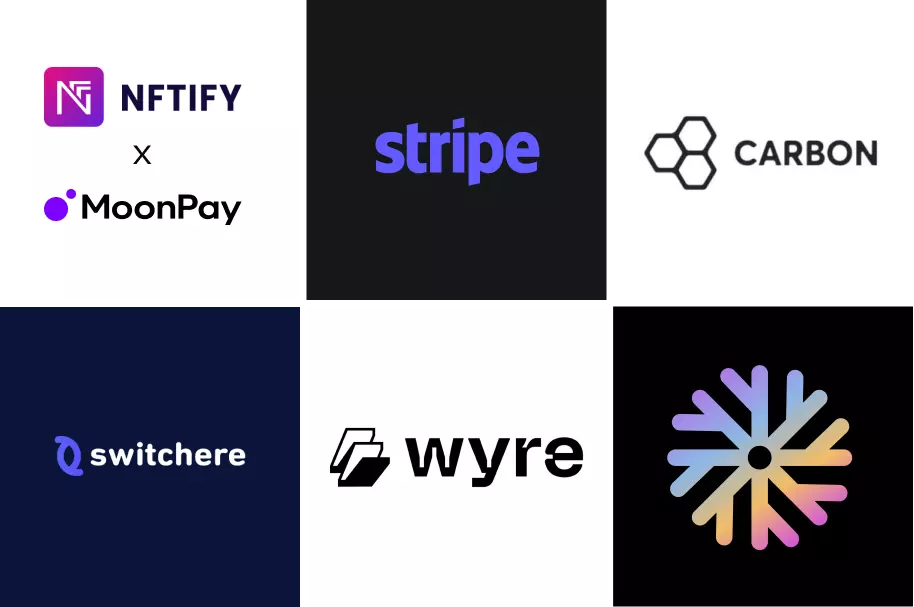Buying NFTs With Credit Cards Made Easy: A Quick Guide


How Is It Possible To Buy NFTs with Cards?
NFT-Focused Payment Solution Providers ﹣ Top 7
What Are The Advantages of Being Able To Buy NFT With Fiat?
Buy NFTs with credit cards - video tutorial
Final Thoughts
FAQs
The barriers to entering the NFT world keep getting leveled to encourage more participation. Gradually, trading or collecting NFTs is fast becoming normal and no longer a big deal.
But can you imagine a world where purchasing NFTs is as simple as swiping your card just like you do on eBay? Study shows that 80% of the average person finds card payment to be more convenient.
As a result, some white-label NFT marketplaces are now including a feature for their buyers to purchase NFT with credit cards. Moving on, we’d be taking a keener look at how fiat payment for NFT works, its benefits, and some well-known solution providers at the moment.
How Is It Possible To Buy NFTs with Cards?
At this point, you must note that fiat payment for NFT works in three different ways:
While the end goal is still the same – that is to buy NFTs with fiat money, different NFT marketplaces employ different ways to make fiat payment work, namely:
1. Use cards to buy cryptocurrencies
As an NFT collector or buyer, you can use your credit card to add funds to your wallet when you don’t have enough crypto. This is especially useful when you already have a crypto wallet and want the cryptocurrencies for more flexibility.
📌 For instance: if an NFT’s floor price is 4 SOL but you only have 3 SOL, you can top up your NFT wallet from your credit card so you can buy one more SOL — or you can even top up the full 4 SOL to your crypto wallet.

For new users looking for a while to ease into the NFT space, this is a good way to start as the crypto is deposited straight into their crypto wallet, allowing for easier NFT purchases.
2. Purchase NFTs Directly with Cards
This is different from topping up more cryptocurrencies into your NFT wallet with credit cards. Instead, you’re paying wholly for the NFT directly with your credit card.
This is how it works: If a collectible is up for 500 MATIC which is around $825, the entire $825 will be deducted and paid from your card. The on-ramp solution provider will do the background job in converting your $825 to 500 MATIC.
That said, you should bear in mind that buying NFTs with credit cards will always require you to pay an exchange fee for the fiat-to-crypto conversion.
Similarly, you'd have to share a few of your details as a way of complying with KYC requirements.
NFT-Focused Payment Solution Providers ﹣ Top 7
There are a couple of emerging onramp and offramp solution providers in the NFT space. We will look into each of them below:

1. MoonPay - Buy and sell Bitcoin, Ethereum, and other cryptos
Perhaps the most popular of them all, MoonPay built its NFT checkout for marketplaces and creators to enhance their user experience through the possibility of purchasing NFTs with credit cards.
The checkout is available for NFT projects that were built on various chains like Tezos, Flow, and Polygon. Collectors can purchase their NFTs through various options like;
- Google Pay
- Samsung Pay
- Wire Transfers
- Apple Pay
- Open Banking
- MasterCard
- Visa, and a few more others.
MoonPay has a large bandwidth of supported currencies—currently more than 30 popular ones—and has secured regulatory permission to facilitate payment across over 160 countries. So far, MoonPay has partnered with popular projects like Jambb, Slope Finance, and Sorare, and yes, NFTify.
On NFTify specifically, buyers can use MoonPay to top up more cryptocurrencies into their crypto wallet, thus enabling an easier time purchasing NFTs:

2. Stripe -Payments infrastructure for the internet
Originally known to facilitate cross-border FinTech payments, Stripe has also joined the Web3 train by providing on-ramp infrastructure for NFT marketplaces, brands, and creators.
With Stripe fiat payment API solution, NFT collectors and supporters across over 180 countries will be able to buy NFT with credit cards with close to 135 fiat currencies.
Stripe prevents frauds from infiltrating your system by double-checking the ID of your buyers. The KYC checks also help to onboard users with just a scan of their ID cards.
3. Switchere - Sell & Buy Crypto Instantly
In December last year, Switchere struck a partnership with SpaceSeven—the first Concordium-based NFT marketplace—to allow the latter’s customers to buy NFT with their credit cards. This was possible through the integration of Switchere’s widget solutions.
The Media and Communications team of Switchere told the public that its partnership with SpaceSeven is the first of many other future partnerships with NFT marketplaces.
It facilitates the on-ramp transactions on credit cards MasterCard, Sepa, Visa, Sofort, and Maestro. In addition, it also supports popular crypto—like ETH—that are mostly used in the NFT market.
4. Wert - Payment solutions for NFT and DeFi
Wert has a top-up module or API that can be integrated into an NFT website or marketplace. This module enhances fiat-to-crypto transactions.
Based in Tallinn, Wert is facilitating on-ramp transactions for NFT platforms and projects like Kalamint, Angle Protocol, and Mintable.
For the sake of compliance, Wert obligates its customers to carry out some KYC tasks including address details, bank details, the images of their ID, and a selfie.
5. Winter - Checkout to sell NFTs via credit card
Co-founded by Laila Chima and Michael Luo last year, Winter is a YC-backed on-ramp solution provider.
NFT businesses and NFT creators can simply integrate Winter into their websites through its checkout widget.
Winter goes beyond facilitating fiat-to-crypto transactions with credit cards, it also helps customers to pay directly with their bank accounts. It recently partnered with Crypto Badger NFT so the supporters of the project can mint NFT with their credit cards.
While Winter plans to add more blockchain networks in the future, it only supports three chains at the moment: Ethereum, Polygon, and Solana.
6. Carbon Money
With Carbon, people can purchase NFTs with either their MasterCard or Visa cards. By integrating its API into your NFT website, buyers will be able to pay in close to 180 fiat currencies of the world.
CarbonMoney requires KYC details including an ID card, selfie, location, and a few other personal data. It claims to keep these KYC details safe with the help of a decentralized data security provider called VGS.
While Carbon claims to have wide global coverage, it's important to note that it is unavailable in about 19 countries including China, North Korea, and Russia, etc.
7. Wyre - The Crypto Stack for the New Economy
Having partnered with NFT marketplaces like OpenSea and DAOs like Maker DAO, Wyre is positioning itself as one of the leading fiat-to-crypto payment gateways.
Currently, Wyre's services are available for NFT projects that are built on Flow, Polygon, Algorand, and Ethereum blockchains. It is available on both Apple Pay and credit cards.
Just yesterday, the 25th of March, Wyre announced being in talks with the Avalanche team for a partnership regarding onramp solutions.
What Are The Advantages of Being Able To Buy NFT With Fiat?
The advantages are mostly there for newcomers to the NFT space.
Buying NFT with fiat doesn’t provide a more seamless purchasing experience – buying with cryptocurrencies still has this advantage, but it gives you the peace of mind that you don’t need to know the ins and outs of the crypto world to make the purchase.
To sum it up, here are the main advantages of being able to buy NFTs with fiat money:

1. Avoid Crypto Volatility
Except for stablecoins, the value or monetary worth of crypto assets fluctuates greatly and is thus unpredictable. For example, the price of Bitcoin and major altcoins dropped by 10% on the 21st of January this year.
But buying your NFT with fiat currencies saves you from the risky crypto price fluctuations; all you have to do is to pay a 4% exchange fee which is relatively better.
2. A Friendlier Option For Non-Crypto Natives
Most people who are not familiar with the crypto world find it hard to understand the processes involved in buying NFTs. But the possibility of fiat payment is a better one because they are already conversant with it.
Indeed, research confirms that at least 90% of the United States population are conversant with credit cards and they use them often. Thus, it is a more direct method of purchasing NFTs.
3. Bypass Crypto Exchanges
NFTs, due to their underlying blockchains, can only be traded for some crypto and you will always need to buy these cryptos from the exchanges which means you'd need to register an account there.
Moreso, sending crypto from an exchange to your crypto wallet might take time sometimes. This might also become extremely time-consuming and unbearable when there are network congestions like what has been happening on Solana for a couple of months now.
But being able to purchase NFTs with fiat cuts away from this relatively long process and ships in a faster buying experience.
In addition, you’d always have to pay a couple of fees when you use exchanges. These include withdrawal fees, transaction free, and probably more. But that is not the case with fiat payment.
On NFTify, you’d only be required to pay a 4% fee for the crypto-to-fiat conversion that went on in the backend.
4. Avoid NFT Gas Fees
Gas fees fluctuate depending on the global demand for the native token of a blockchain network.
There are days when the gas fees of Ethereum can cost up to $500 per transaction. While there are ongoing attempts to reduce gas fees, fiat payment for NFT brings a handy solution.
Buy NFTs with credit cards - video tutorial
Final Thoughts
Being able to buy NFTs with credit cards will bring a fresh set of buyers to the NFT landscape. A lot of people who have been kept away because of the complexities of crypto can now ape into NFTs with their credit cards.
By extension, fiat payment for NFTs will not only onboard new sets of buyers but also bring more solution providers to the space.
With NFTify, launching your own NFT marketplace with fiat payment options is done in relatively no time and without any upfront costs. Our platform is integrated with both Moonpay for crypto top-up and Wert for fiat payment.
📌 Try opening one for FREE today: https://nftify.network/
📌 Be a part of the NFTify community on Telegram, Twitter, Youtube

FAQs
1. Can I buy NFTs with credit cards?
Yes, it is possible to purchase your NFTs with credit cards if the platform is integrated with an onramp solution provider.
2. Where can I buy NFTs with credit cards?
You can simply buy NFTs with credit cards from stores built on NFTify platform.
3. Will I pay any fee if I buy NFTs with credit cards?
Yes, you will have to pay for the fiat-to-crypto conversion. NFTify charges a standard, minimum exchange fee of 4% from the buyers.
4. What are the advantages of buying NFTs with credit cards?
Buying NFTs with credit cards is more direct and friendlier with non-crypto users. It will also help you to avoid crypto volatility and gas fees.
5. What credit cards do most NFT platforms support?
Most NFT platforms always support MasterCard, Visa, Apple Pay, and Google Pay.

with NFTify today
matter of hours, without a single line of
code or any upfront cost.
